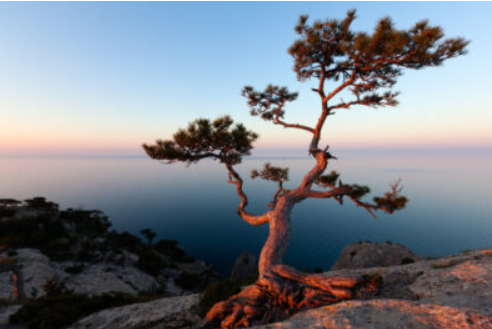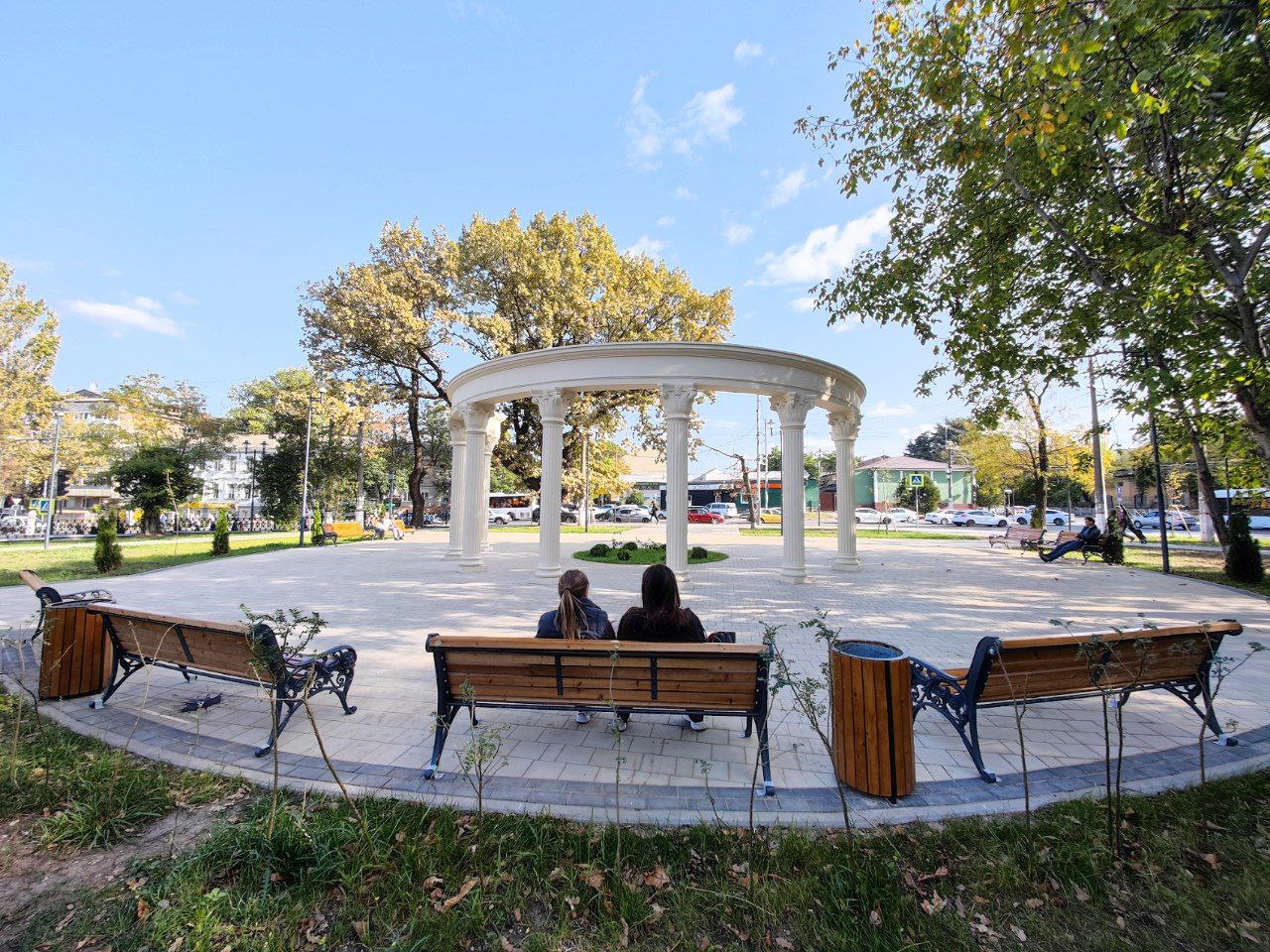The spring in Crimea is a special period, which should be called a period of blossom and rush of power. A spring is a time segment, when a person should travel, observe and soak up a spring Crimean mood. Every Crimean city and every local place is famous for its sightseeing attraction and its own particularity. It’s impossible to visit all these places during a single trip, but there are such objects of interest that can’t be overlooked.
Crimean natural park
The Crimean natural park is the largest nature reserve in the peninsula. Here, you will be able to enjoy seeing picturesque views of the Chatyr-Dag, Kemal-Egerek, Demir-Kapu and Roman-Kosh. More than 1200 types of plants grow at the natural park. Tourists can see the most beautiful Uch-Kosh gorge and Windy Arbor on its territory, as well as attend a dendro-zoo and unique trout farm.
People are allowed to visit the nature reserve only through special permits.
Uchan-Su Waterfall / Yalta
It’s the highest waterfall of Crimea (98,5 m) and the most fascinating one. The waterfall is especially wonderful in spring. The flow of the waterfall is visible from a distance in the background of the dark-grey precipices. A thunderous roar of throwing down water echoes far away around and jet of water is covered by an opaque veil made of water mist. The Greeks called it the Kremasto-Nero (translated as hanging water), as for Tatars, they gave the name Uchan-Su (translated as flying water) to it. Uchan-Su is located about 4 km away from Yalta. Three smaller waterfalls are formed below. There is the observation platform on the Eagle Flight Mountain, where surrounding mountains and river valley of Uchan-Su are clearly visible from. The Taraktashskaya and Shtangeyevskaya hiking trails start from this platform. The stand-alone Isar-Tepe rock is located below the waterfall at the river. The ruins of the Greek-Byzantine castle built in the Xth century were preserved on the top of the rock. The noise of falling water, amazing pine forests and mountain air, filled with resin aroma made this nature area deserved glory and turned it into one of the most attractive places of the Southern Shore of Crimea.
How can you reach?
Catch the local bus with the sign plate “Ai-Petri through the Uchan-Su waterfall” in it at the bus station of Yalta.
Kara-Dag natural park. Kara-Dag Mountain Range / Koktebel
The volcanic massif Kara-Dag is the main sightseeing attraction of blessed Koktebel. You will be allowed to visit the nature reserve only with an excursion group, but it’s prohibited to do it on your own. The main sightseeing walking route was paved among the fancy sculptures, rock formations and volcanic landscapes to observation platforms, where tourists can enjoy magnificent views to the coastal cliffs, crags and cozy bays. Visitors can depart for a boat trip along the shores of Kara-Dag from Koktebel. The rock massif looks like more majestic and amazing from the sea. It’s possible to see the symbol of Kara-Dag, which is mostly known as the Golden Gate rock. Then, if a tourist decides to go on foot with an excursion group across Kara-Dag, so it will be an optimal choice — you can watch all the amenities of Kara-Dag from different angles, they are worth it.
How can you reach?
Choose the route Simferopol — Feodosiya — Koktebel — Shchebetovka — Kurortnoye.
Valley of Ghosts. Demerdzhi Mountain / Alushta
If you walk through the trails of Demerdzhi that rises above Alushta, you will get an opportunity to awake your fantasy, inhale the heady aroma of mountain herbs and take a trip into a mysterious world full of enigmatic creatures. The title Demerdzhi is translated as the Smith Mountain from the Turkic languages: according to the legend, a cruel smith lived on the top of the mountain, whose bloodlust destroyed the amazing girl Maria. Her image can be seen on one of the hills of the mountain (truly speaking, many people recognize hard face features of the empress Yekaterina in this female profile). The ruins of the Funa Fortress were preserved at the foot of the mountain. The fortress was the outpost of the Principality of Theodoro. The word Funa means “smoky”: very often, clouds descend on the slope, where the fortress was situated on, therefore an illusion of the tight smoke is created. Ghosts live on the Western hill of Demerdzhi — during centuries, winds traveling along the local mountains created the fancy sculptures from the rock formations. If you look attentively and dream up a little, so you will be able to see silhouettes of birds, reptiles, animals, fabulous characters and people, splendid castles and enigmatic pyramids in these stone idols. The exciting impression from the journey through the Valley is complemented by a magical view from the mountain to White Alushta and villages surrounding the city — it may seem that this part of the world can fit in the palm.
How can you reach?
Get on the local bus or trolley bus moving from Simferopol to Alushta. Get off at the “Luchistoye” bus stop before reaching Alushta.
Snowdrop glades on Ayu-Dag
If you want to present the fairy tale “The Twelve Months” to your sweet heart, then you should go together for snowdrops. This period, fragrant glades of first amazingly beautiful flowerings bloom on the Western hill of the Ayu-Dag Mountain. But don’t pick the flowers, give a rapture of contemplation to your sweethearts, as many as you can span. Once, people lived on the Bear Mountain, but the area is uninhabited after the earthquake of 1423. Only processions of people continue climbing the slope that rises 577 meters up above the sea. There are rumors that humanoids like this place very much and they even established a filling station here. You can find yourself in a very interesting company. If you want not to get lost your way, we advise you to go in the group with a guide.
Vorontsov Palace. Park of Alupka / Alupka
The Palace of the Count Vorontsov is one of the architectural and historical pearls of Crimea. Nine ceremonial halls introduce tourists to the palace interiors of the 30s-40s of the XIXth century. The static exhibition “The Vorontsovs’ family gallery” is shown at the former guest pavilion, where the visual art is displayed in, which is connected with several generation of the families of the Vorontsovs and Dashkovs-Vorontsovs, as well as their relatives — the Shuvalovs, the Naryshkins and the Dolgorukiye, who were the owners of the large estates in Crimea. The Vorontsov (Alupka) Palace will only bring positive emotions for visitors in this season of the year.
The castle is surrounded by a romantic park, which forms a single ensemble with the Vorontsov Palace. Being marked on the principle of an amphitheater, the whole composition contains spatial connections oriented to cardinal points and extending from the base of the amphitheater — from the “Tea Cabin” located on the coast of the sea — to all architectural objects of the park, palace and to all visible and invisible centers of the landscapes. There are about 200 of exotic plants of tree and shrubbery types, species and garden forms. The coastal highway divides the park into the Upper and Lower ones. The Upper Park is literally saturated with natural zests: here you can find hard stone chaoses, reflecting ponds, fragments of natural forests of the Southern Shore of Crimea and groups of beautiful foreign trees. They all have got poetic names: Moon stone, Little and Big chaoses, Trout, Reflecting and Swan lake, as well as Platanus, Sunny, Contrast, Chestnut glades. The “Trilbi” fountain attracts attention too. The Lower Park was designed in the style of the gardens of the Renaissance. The “Fountain of Tears”, which is the variant of the famous fountain in Bakhchisarai glorified by Pushkin A.S., the “Shell” fountain, the springs “Kitty’s Eye” and “Tea Cabin”, the rock of I.K.Aivazovsky and finally, it’s a lion terrace with three couples of lions made of the white marble, which are sleeping, wakening and already wakeful.
How can you reach?
Catch the bus moving from Yalta to the Palace. After, you have to go on foot along the asphalt road during 10 minutes to the Northern Ceremonial Yard.
Massandra Museum-Palace / Massandra
The palace is located in the secluded place in the Upper Massandra and surrounded by the splendid park turning into the wood. The exhibition “Unique collection of geographical maps of the XVIth and XVIIth centuries” constantly functions at the palace. The French architect M.E. Bouchard started building the palace for the Prince Vorontsov S.M. in 1881. Then, the construction was suspended and resumed only when the Imperial family bought these lands in 1889. This palace was called the Little Versailles because of its luxury and elements of ornamentality.
How can you reach?
Get on the bus in Yalta and reach the “Upper Massandra” bus stop.
Livadia Museum-House / Livadia
The Livadia Palace near Yalta is the architectural and historical monument. It was the Crimean residence of the Russian Emperors, but this palace firmly came down in history as the place, where the famous conference of the allied countries was held during the World War II. The palace and park ensemble is the pride of Crimea and it looks more solemnly in spring. The White Livadia Palace was built on the site of the Old Big Palace in 1911 according to the project of the architect Krasnov N.P. from Yalta, who received the rank of Academician of the Russian architecture and court architect for raising of this palace and range of other palace facilities on the Southern Shore of Crimea. The Livadia Palace is the summer residence of the last Russian Tsar and then it was turned into the first sanatorium for peasants in the 20s-30s of the XXth century and in the end of the World War II, the palace became a meeting place for the leaders of three allied states USSR, USA and Great Britain, where the issues of the post war peace order and establishing of the UN were discussed. In the post war period, the facility became the state villa of Stalin I.V., later it became the body of the Livadia sanatorium and then it was turned into the museum. Currently, visiting the museum, excursionists get an opportunity to see the interiors and room arrangement of the imperial family, as well as enjoy the art exhibitions and collection of paintings of the modern Crimean painters.
How can you reach?
Buy a ticket for a bus at the bus station of Yalta and get off at the “Livadia Palace” bus stop.
Khan’s Palace / Bakhchisarai
Attending the Khan’s Palace, you will be able to come into contact with the fantasy world of East. Annually, thousands of people from all corners of the Earth aspire to arrive in Bakhchisarai to see firsthand the “Fountain of Tears” glorified by Pushkin and enjoy fancy creatures of the ancient masters.
In the past, the Khan’s Palace was the residence of the Crimean khans. Nowadays, it’s the complex of the cultural-historical nature reserve of Bakhchisarai. The total area of the Khan’s Palace is more than 4 hectares. Here, tourists can find 14 main objects, which are open to the public. The “Fountain of Tears”, Divan Hall and Harem are among these objects. Moreover, there is the Museum of History and Culture of Crimean Tatars and Museum of Art within the spaces of the palace.
How can you reach?
Follow the highway Simferopol — Bakhchisarai.
The address: the town of Bakhchisarai, Rechnaya Street 133.
Genoese Fortress / Sudak
The fortress is rightly called a visiting card of Sudak. It is one of the most impressive architectural-historical monuments of the medieval Crimea and the only stronghold, which was preserved on its territory. The Consular Castle was rebuilt. Tourists can have a look at the remains of the temples, water storages, three walls of the Observation Tower with the fireplace niche, remains of the stone staircase, niches and round tower of the Byzantine setting. Furthermore, the home chapel devoted to Saint Mary. The Corner Tower built in 1386 is situated near the Observation Tower.
The rare footages from the films “Amphibian Man”, “Pirates of the 20th Century” and “Master and Margarita” were shot there.
How can you reach?
Follow the highway Simferopol — Sudak — settlement Noviy Svet.
Yevpatoriya (Small Jerusalem: Dervish Tekie — Synagogue — Karaite kenassas — Juma-Jami Mosque)
The excursion title “Small Jerusalem” was chosen not accidentally as the medieval part of Yevpatoriya looks like Jerusalem. All the tourist objects we are interested in are located not far from each other and that’s why guests of the town can visit all of them going on foot. The excursion begins at the Gate of the Wood Bazaar. That time, Yevpatoriya was called Gezlev and the largest gate in the town was raised, where merchants were selling fire woods at. There is a unique construction Dervish Tekie in front of the gates (they are also called the Gezlevskie). It’s a tenement of dervishes (it means travelling sophists) of the XVIth and XVIIIth centuries. The Shukurulla-Efendi mosque with a high minaret is the part of the museum complex. This was a facility, where dervishes went into a trance. This is the only Moslem institution of such type that was preserved in Crimea. There are Turkish baths built in the XVIth century near the Dervish Tekie. The bath facilities functioned about 500 years until the 80s of the XXth century. If you go deep into the town, you will see the Armenian Cathedral of St. Nicholas. The Russian and Armenian traditions are combined in its architecture. The only Judaic construction of Yevpatoriya called the Egie Kapai Synagogue is located not far from there. It was built in 1911 and now the synagogue is the architectural-historical monument of the town. The religious building of the Jewish nation that are mostly known as the Karaite kenassas were preserved too. At the present moment, this outdoor museum has been renovated — it possesses the well-kept territory with white marble slabs. Further, the itinerary takes us to the Juma-Jami Mosque. The architect, who designed the mosque, also worked on the grand Hagia Sophia in Istanbul. Every day, people can hear a voice of a mullah from the top the 27 meter minaret calling on Moslems to perform Namaz. Tourists are allowed to enter the mosque with a guide, where they will get an opportunity to get acquainted with the traditions of the Moslem nation.
How can you reach?
Get on the bus moving from Simferopol to Yevpatoriya (the old part of the town near the embankment named after Valentina Tereshkova).
Information source: Tourist Portal of the Republic of Crimea
Reference: Crimean Magazine






